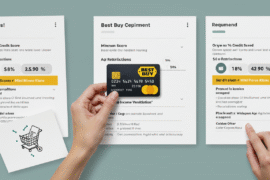This article may contain references to products or services from one or more of our advertisers or partners. We may receive compensation when you click on links to those products or services. Nonetheless, our opinions are our own.
The information presented in this article is accurate to the best of our knowledge at the time of publication. However, information is subject to change, and no guarantees are made about the continued accuracy or completeness of this content after its publication date.
Credit cards can be powerful financial tools, offering convenience and rewards, but without careful management, they can also lead to costly debt. For Canadians looking to save money and manage credit wisely, adopting effective strategies is essential. This article outlines practical ways to save money on credit cards while maintaining healthy credit and reducing debt.
- Prioritize Paying Down High-Interest Debt
- Use Budgeting and Automation to Control Spending
- Choose Credit Cards That Minimize Fees and Maximize Rewards
- Avoid Interest Charges by Paying Balances in Full
- Take Advantage of Signup Bonuses and Promotional Offers
- Use Cashback Apps and Shopping Portals for Extra Savings
- Avoid Foreign Exchange Fees When Traveling or Shopping Internationally
- Monitor and Reduce Other Costs Associated with Credit Cards
- Build an Emergency Fund to Avoid Relying on Credit
- Recommended Reads
Prioritize Paying Down High-Interest Debt
According to an article by Credit Canada Debt Solutions, the first step in saving money with credit cards is to focus on paying down high-interest debt before concentrating on savings. Credit card interest rates in Canada often range between 19% and 21%, which can quickly accumulate if balances are carried month to month. Prioritizing repayment of high-interest balances reduces the amount of interest paid, freeing up money to save or invest.
Incorporating debt repayment into your budget and making at least the minimum payments on all debts helps reduce interest charges over time. Additionally, consolidating debt into a lower-interest option, such as a personal loan or a balance transfer credit card, can accelerate debt payoff and reduce costs
Use Budgeting and Automation to Control Spending
A key way to save money on credit cards is to control spending through budgeting and automation. RBC Royal Bank’s financial roadmap advises Canadians to set up automated payments for both debt repayment and savings contributions. Automating payments ensures bills are paid on time, avoiding costly late fees and interest penalties, while also helping to build an emergency fund simultaneously
Automation removes the risk of forgetting payments and helps maintain discipline, which is crucial for managing credit cards effectively and avoiding unnecessary charges.
Choose Credit Cards That Minimize Fees and Maximize Rewards
Selecting the right credit card can significantly impact your savings. According to Finly Wealth, Canadians should look for cards with low or no annual fees, reasonable interest rates, and rewards programs that align with their spending habits. For example, cards like the American Express Cobalt® offer generous points on groceries, dining, and streaming services, while the Scotiabank® Platinum American Express® Card provides low-interest rates and no foreign exchange fees, saving money on international transactions
Using cashback or rewards cards strategically—such as on everyday purchases you would make regardless—can help offset costs and even generate savings. However, carrying a balance on high-reward cards can negate these benefits due to interest charges, so paying balances in full is critical.
Avoid Interest Charges by Paying Balances in Full
One of the simplest yet most effective ways to save money on credit cards is to pay your statement balance in full each month. According to Finly Wealth, interest charges on unpaid balances can quickly erode any rewards earned and increase overall debt. Paying on time also helps maintain a good credit score, which can qualify you for better credit products with lower rates in the future
Setting up reminders or automatic payments can prevent missed due dates and late fees, which add unnecessary costs.
Voted "Best Overall Budgeting App" by Forbes and WSJ
Monarch Money helps you budget, track spending, set goals, and plan your financial future—all in one app.
Get 50% OFF your first year with code MONARCHVIP
Take Advantage of Signup Bonuses and Promotional Offers
Many Canadian credit cards offer signup bonuses that can add significant value if you meet the spending requirements. For instance, some cards provide cash bonuses or extra points after spending a certain amount within the first few months. Taking advantage of these offers can boost your rewards without additional spending.
Moreover, issuers often run seasonal promotions or limited-time cashback offers at popular retailers. According to Financial Post, signing up for card issuer newsletters and monitoring offers can help you capitalize on these opportunities to save money
Use Cashback Apps and Shopping Portals for Extra Savings
Beyond the credit card itself, cashback apps and online shopping portals offer additional savings. By making purchases through portals affiliated with your credit card issuer or third-party platforms like Rakuten, Canadians can earn extra cashback on top of their card rewards. This “double-dipping” strategy maximizes returns on everyday spending
Avoid Foreign Exchange Fees When Traveling or Shopping Internationally
Foreign exchange fees can add up quickly when using credit cards abroad or on international websites. Financial Post highlights that many Canadian credit cards charge fees of around 2.5% on foreign transactions. Choosing cards that waive these fees, such as the Scotiabank® Platinum American Express® Card, can save you money if you travel frequently or shop online from foreign retailers
Monitor and Reduce Other Costs Associated with Credit Cards
Additional costs like late payment fees, over-limit fees, and cash advance charges can add up. To minimize these, always pay on time, keep your spending within your credit limit, and avoid cash advances unless absolutely necessary. According to Credit Canada, being aware of these fees and managing your account responsibly is key to saving money
Build an Emergency Fund to Avoid Relying on Credit
Having an emergency fund reduces the need to rely on credit cards for unexpected expenses, which often come with high-interest rates. RBC Royal Bank recommends building savings equal to three to six months of expenses to cover emergencies. This financial cushion helps prevent debt accumulation and supports long-term financial health2.
By focusing on paying down high-interest debt, automating payments, choosing the right credit cards, paying balances in full, and leveraging rewards and promotions, Canadians can save money on credit cards and improve their financial well-being. Combining these strategies with disciplined budgeting and emergency savings builds a strong foundation for managing credit and debt effectively.
Sources:
- According to an article by Credit Canada Debt Solutions, prioritizing high-interest debt repayment is the first step to saving money on credit cards
- RBC Royal Bank’s 2025 Financial Roadmap emphasizes automating debt payments and savings contributions to avoid fees and build financial security
- Financial Post highlights the importance of using credit cards without foreign exchange fees and taking advantage of promotional offers to save money

Reviewed and edited by Albert Fang.
See a typo or want to suggest an edit/revision to the content? Use the contact us form to provide feedback.
At FangWallet, we value editorial integrity and open collaboration in curating quality content for readers to enjoy. Much appreciated for the assist.
Did you like our article and find it insightful? We encourage sharing the article link with family and friends to benefit as well - better yet, sharing on social media. Thank you for the support! 🍉
Article Title: Saving Money on Credit Cards in Canada: Smart Strategies for Credit and Debt Management
https://fangwallet.com/2025/06/09/saving-money-on-credit-cards-in-canada-smart-strategies-for-credit-and-debt-management/The FangWallet Promise
FangWallet is an editorially independent resource - founded on breaking down challenging financial concepts for anyone to understand since 2014. While we adhere to editorial integrity, note that this post may contain references to products from our partners.
The FangWallet promise is always to have your best interest in mind and be transparent and honest about the financial picture.
Become an Insider

Subscribe to get a free daily budget planner printable to help get your money on track!
Make passive money the right way. No spam.
Editorial Disclaimer: The editorial content on this page is not provided by any of the companies mentioned. The opinions expressed here are the author's alone.
The content of this website is for informational purposes only and does not represent investment advice, or an offer or solicitation to buy or sell any security, investment, or product. Investors are encouraged to do their own due diligence, and, if necessary, consult professional advising before making any investment decisions. Investing involves a high degree of risk, and financial losses may occur including the potential loss of principal.
Source Citation References:
+ Inspo
There are no additional citations or references to note for this article at this time.












































